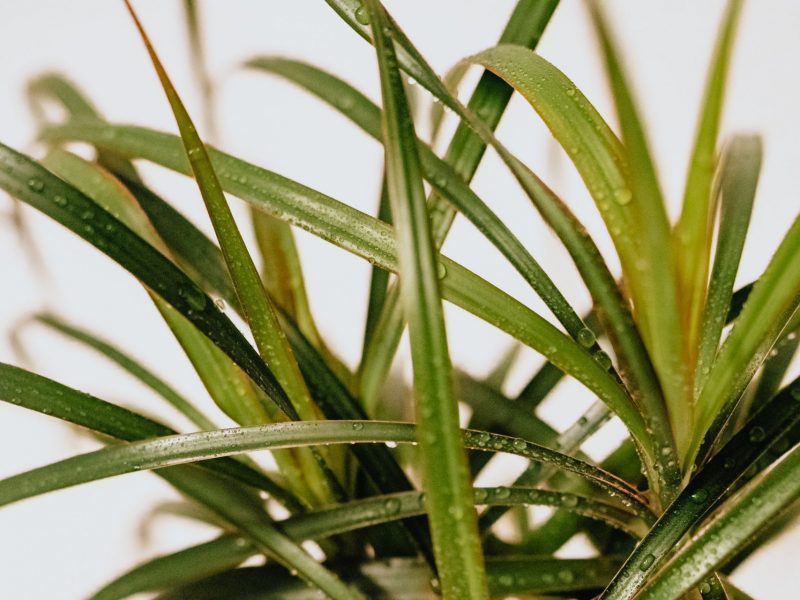
If your Dragon Tree looks a little limp and has started to droop down then this definitely suggests that there is something wrong. However, you’ve come to the right place as below we will not only be going through all the different causes of a drooping Dragon Tree but will also guide you through how to fix and prevent the issue so you can keep your plant thriving.
A drooping Dragon Tree can often mean overwatering
Overwatering is one of the biggest and most common problems in the houseplant world as it can cause a whole range of issues that some plants can not recover from. It’s also tricky because by the time it shows up as a visible issue on your plant, the issue has been slowly rotting the root system without you even knowing. However, if the leaves are drooping but are still quite green and healthy then the problem should not have advanced enough so that your plant is unsalvagable.
The reason that overwatering is so damaging is that it can very quickly lead to root rot which means the plant is unable to take up nutrients and water from the soil. This leaves your Dragon Tree quite droopy and unstable.
If you think your Dragon Tree might be suffering from overwatering and root rot replace the potting mix right away and trim away any rotten roots. Moving forward, adjust your watering schedule to either water less deeply or less frequently. It can take a little longer for the plant to recover from overwatering than some other issues due to the damage to the root system so don’t give up straight away!
Underwatering can also cause drooping stems and leaves
The strange thing about drooping leaves on a Dragon Tree is that as well as too much water, they can also be caused by not enough water. Consistent underwatering can lead to a variety of issues but the first of which will tend to be a drooping plant. Underwatering won’t kill your plant as quickly as overwatering but still needs to be treated quickly to prevent the root system from crisping up.
Before you start watering more frequently, we recommend taking your plant out of the pot and seeing how dry the potting mix feels. You want to be sure that underwatering is causing the drooping plant as you don’t want to increase watering if that isn’t the issue.
Once you are sure that the soil is bone dry and it’s underwatering that is causing your Dragon Tree to droop, then slowly reintroduce watering. Your first instinct might be to drown the plant in water but this can actually cause more damage and more brown leaves. This is because plants get shocked by a sudden change in the environment.
Instead, the best way to solve the underwatering issue is to water your Dragon Tree plant a little bit once a day for a week. After a week you want to go back to a more normal care routine, making sure to check the moisture in the soil frequently to avoid the leaves drooping again. Picking up a moisture meter will make this easier to monitor and help you establish a better watering routine.
Poor drainage could also be the issue
It might not be the amount or frequency of water that is harming your plant but actually the lack of drainage in the pot that is impacting the root system and causing drooping leaves. If not enough of the water is draining, then waterlogged soil can very quickly start causing issues.
You can very easily increase the amount of drainage in your soil by mixing in a small amount of perlite. This will make it far easier for water to flow through and out of the drainage holes of your pots (you should also check to make sure your pots have drainage holes).
If your Dragon Tree is in a plastic pot, we also recommend switching this out to a terracotta or clay pot. These allow some of the excess water to evaporate out of the sides of the pot. We love these terracotta pots from Amazon.
By increasing the drainage, it ensures that your plant won’t start dying if you just overwater it a little here and there.
Pests are a worrying cause of a drooping plant
A rarer but equally important cause of drooping leaves on Dragon Trees (and most other houseplants), is a pest infestation. It can be worrying for plant parents to think that pests might be making a home on their plants but if you catch the problem early, there are several ways you can combat the issue. The reason that pests cause drooping leaves and stems is that they suck the nutrients from your plant, exhausting it.
Pests don’t tend to be common on plants that don’t spend any of the year outdoors, but it can still happen. The first thing to do is isolate your infected plant away from your other houseplants to stop any spread of the pests (they can jump around close hanging leaves). T
Then inspect your plant closely to spot any further signs, beyond drooping leaves, that indicate bugs are living on your Dragon Tree. The most common signs include yellow or brown spots on the leaves, holes in the leaves and white webbing across the stems. Using a magnifying glass will really help you spot any crawling around on the leaves.
If you do spot any signs of pests, cut away the worst affected leaves and replace the potting mix entirely to curb the growth of the infestation. Then wash down the leaves and soil in the shower using warm water and wipe over them with a clean cloth. We also recommend treating your Dragon Tree with neem oil and showering every few days.
Those are the most common reasons why Dragon Trees start drooping down. The key to quickly and painlessly solving the issue is to catch it as soon as possible. This is why we highly recommend that all plant parents give their plants quick check-ups every now and again to spot any early warning signs. We like to do this each time we water and then give more thorough check-ups once a month.
To learn more about how to keep your plant thriving, check out our Dragon Tree care guide.














